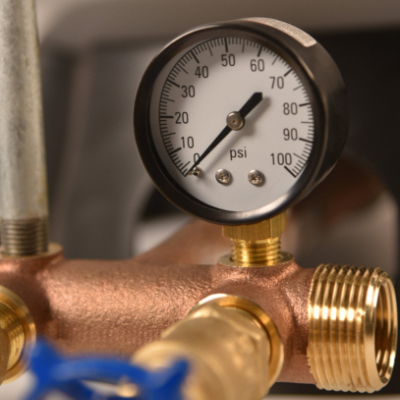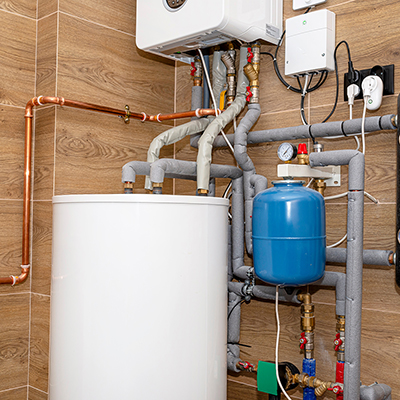Essential Types of Drain Cleaning Equipment

Last updated March 19, 2025
Cleaning your clients’ drains and pipes requires plumbing supplies that combine power and precision. Pipes are most likely to get clogged during the winter months when cold temperatures cause grease and other materials to solidify in the plumbing, making them more prone to blockages. Improperly insulated pipes are even more prone to debris buildup.
This guide reviews how to choose the best types of drain cleaning equipment for your jobs, as well as equipment maintenance and the difference between drain clearing and drain cleaning.
Table of Contents
Types of Drain Cleaning Tools
Choosing the Right Drain Cleaning Tools
What’s the Difference Between Drain Clearing and Drain Cleaning?
Maintaining Your Drain Cleaning Tools
More Tools. More Products. More Perks.
Types of Drain Cleaning Tools

From removing minor clogs to solving major plumbing problems, you must match drain cleaning tools to the size and seriousness of the job. When servicing drain pipes in residences or commercial buildings, especially during winter months, consider the following types of drain cleaning tools:
- Chemical drain cleaners or openers use lye, acids or other substances to dissolve or break down clogs. Use with caution as they can cause burns and damage certain types of pipes.
- Plungers are the most basic type of manual clog-clearing tool and consist of rubber cups and wooden or plastic handles.
- Drain snakes, also called drain augers or plumber’s snakes, are manual tools that consist of coiled cables that can be fed into a pipe. Drain snakes often have screw-shaped ends or attachments that are effective at breaking up clogged debris. Most manual drain snakes have an effective range of 25 feet, and telescoping models can be best for clogged toilets.
- Drum cable machines, also called sewer machines, are motorized augers powered by gas or electricity to apply more force than handheld models. Compared to manual drain snakes, they are more effective with larger or more distant clogs. They include cables in a single continuous unit and can clear clogs faster than models with sectional cables. Drum machines are effective with drains between 3/4- to 10 in. in diameter.
- Sectional cable machines are a type of drum cable machine that uses cable in sections instead of one continuous length. They tend to be easier to transport than continuous cable machines but can take longer to operate.
- Water jetter cleaners, also called hydro jetters or sewer jetters, use water under high pressure to clean the interiors of pipes or sewer lines. Water jetters can apply force up to 35,000 psi, depending on the model.
- Air-burst cleaners apply high-pressure carbon dioxide, air or other gasses to loosen or disintegrate debris.
Pro Tip: Specialty drain cleaning tools include shower drain snakes, toilet snakes and sink drain snakes.
Choosing the Right Drain Cleaning Tools

When renting drain or sewer cleaning tools for jobs at residential or commercial buildings, be sure to select the right equipment based on the specifics of the work.
Drain cameras attach to cables to inspect pipes from the inside. Featuring color cameras and monitors, they can save time by taking the guesswork out of determining problems and making repairs.
Determine these drain cleaning tools for rental based on size:
- Small models include toilet augers and drain cleaners for small drain lines (1 1/4- 3 in.) in household kitchens, bathrooms and laundry rooms. These models have small-diameter cables flexible enough for tight bends and corners. Manual drain snakes are usually sufficient for clogs in sinks, basins or laundry tubs.
- Medium-sized drain cleaners include manual and electric drain clog remover machines that can reach from 50 to 75 feet through 3- to 4-inch wide pipes, gutters and downspouts.
- Large professional drain cleaners are more heavy-duty than the residential models and can remove tree roots that clog plumbing lines. They are more suitable for commercial buildings and sewer systems.
In winter, pipes can be more likely to freeze or burst inside and outside of a home or business. In the aftermath of a burst pipe or other major plumbing job, you may need to rent supplemental equipment for water remediation.
Water pumps remove standing water from residences, office buildings and more. A blower and dehumidifier rental can help dry out spaces faster and reduce water damage. In addition, rock salt can make a job safer if ice is on the ground.
Pro Tip: For more information, see “The Full Guide: Water Damage Remediation.”
What’s the Difference Between Drain Clearing and Drain Cleaning?

Plumbers hired to remove clogs must choose the best tools depending on whether the job involves simple drain clearing or more complex drain cleaning.
- Drain clearing is unclogging pipes by removing or dislodging the debris that causes an obstruction. This can be a temporary fix if it doesn’t address the source of an ongoing problem.
- Drain cleaning includes clearing the pipes as the first step in a process that often involves scrubbing the pipe walls of grease or other built-up material.
Signs that a business or residential client’s plumbing requires a deeper cleaning include:
- Clogs that recur over time
- Multiple clogged drains at the same time
- Standing water in sinks, showers or around appliances
- Strong odors from drains
- Higher than usual customer water bills
The following are the major steps of a drain cleaning:
- Inspect the pipe with a drain camera to identify the source and extent of the problem. Small clogs can cause big problems if the pipe walls have thick layers of grease, mineral deposits, etc. that have built up over time.
- Clear the main obstruction using an auger.
- Clean the pipe walls with a thorough method such as a high-pressure water jetter.
- Repair or replace pipes that have been damaged.
Pro Tip: Some older pipes can be damaged under the high pressures of water jetter and air-burst cleaners. Check the plumbing system’s age, condition and type of material before using a high-pressure cleaner.
Maintaining Your Drain Cleaning Tools

Cleaning and maintenance will extend the life of drain cleaning tools and make breakdowns on the job less likely. Follow these maintenance steps with your drain and sewer cleaning tools at least twice a year or according to the manufacturer’s instructions:
- Inspect power tools for faulty switches, damaged power cords, missing ground prongs and other signs of damage. Repair or replace damaged components if possible.
- Check the drum belt for wear or damage. Replace belt guards that are missing or damaged.
- Check the drain cable for holes, kinks or other damage and repair or replace if possible.
- Oil the cable to ensure that it generates less friction during use and lasts longer.
- Inspect and clean the power cable feed. Clean the feed rollers and replace if damaged or malfunctioning.
- Clean and lubricate all bearings, bushings and other moving parts at least twice a year.
Pro Tip: Homes with water filtration systems can reduce the amount of mineral deposits in pipes. Learn more in our guide “Common Types of Water Filters and How They Work.”
More Tools. More Products. More Perks.

Be more competitive and boost your bottom line with Pro Xtra, The Home Depot’s loyalty program built for Pros. Sign up today to access the enhanced Pro Online Experience, built with the online business tools and time-saving features Pros need.
Use our tool and large equipment rental services for access to heavy-duty equipment for construction jobs.




























